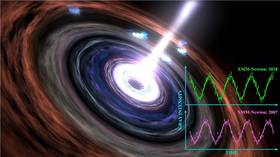Heart of darkness: Researchers detect pulsing rhythm from supermassive BLACK HOLE 600 million light years away

Scientists have rediscovered the ‘heartbeat’ from a supermassive black hole 600 million light years away, after it went missing for several years.
The black hole beats at the center of a galaxy far, far away called RE J1034+396, and was first detected over a decade ago, in 2007. The heartbeat is the result of matter falling into the hole and crossing the event horizon, releasing enormous bursts of energy that create a repeating pattern in the process.
The nature of and spacing between these beats inform scientists about the size of the black hole itself, as well as the structure and composition of the space around it. When it was initially discovered, scientists recorded it every hour until it was blocked by our sun in 2011.
According to lead author Dr Chichuan Jin, of the National Astronomical Observatories in China, and Durham University in the UK, the heartbeat proves that signals from supermassive black holes can be both strong and persistent. It provides scientists with a unique opportunity to study this type of behavior, with a view to improving humanity’s understanding of the terrifying cosmic beasts lurking in the darkness of the universe.
Also on rt.com Closest black hole to Earth discovered just 1,000 light years away, ‘VISIBLE’ to the naked eye“The only other system we know which seems to do the same thing is a 100,000-times smaller stellar-mass black hole in our Milky Way, fed by a binary companion star, with correspondingly smaller luminosities and timescales,” says Professor Chris Done, of Durham University’s Centre for Extragalactic Astronomy.
Now that scientists have rediscovered the heartbeat signal, they will perform a detailed analysis of it before comparing and contrasting their findings with the behavior of stellar-mass black holes in our own Milky Way galaxy.
Think your friends would be interested? Share this story!














